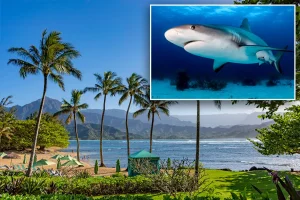Hawaiian Paradise on Pause: Shark Bite Incident Closes Popular Beach
In a concerning turn of events that has disrupted the idyllic atmosphere of one of Hawaii’s most beloved destinations, Hanalei Bay on Kaua’i island has been temporarily closed to visitors following a shark bite incident. On November 5, shortly after 3 p.m., a local surfer encountered a shark while swimming in the bay’s waters, resulting in leg injuries that required immediate medical attention. First responders quickly arrived at the scene to provide treatment before transporting the injured surfer to Wilcox Medical Center. As of now, authorities haven’t been able to determine the shark’s species or size, and updates on the surfer’s condition remain unavailable. This unfortunate event has transformed a typically bustling vacation spot into a restricted zone, with “Shark Sighted” and “No Swimming” signs prominently displayed along the shoreline.
The response to the incident has been swift and comprehensive, with local authorities implementing standard safety protocols to ensure public protection. Lifeguards have been dispatched to patrol the coastline, actively warning tourists to stay out of the water until further notice. This cautious approach reflects the seriousness with which Hawaiian officials treat such incidents, prioritizing visitor safety while recognizing the unpredictable nature of marine wildlife encounters. The closure hasn’t been limited to Hanalei Bay alone—Po’ipū Beach, situated approximately 45 miles away, also implemented swimming restrictions after spotting a 3-to-4-foot reef shark in nearby waters just two hours after Wednesday’s attack. This coordinated response demonstrates the interconnected nature of Hawaii’s beach safety systems and the quick communication between different coastal management teams.
The incident at Hanalei Bay represents just one of several shark encounters recorded in American waters this year. According to trackingsharks.com, 16 shark bites have been reported throughout the United States in 2025 as of October 12, with this recent incident adding to Hawaii’s tally. While shark attacks often capture headlines and stir public concern, they remain relatively rare occurrences when considered alongside the millions of beach visits that occur annually across Hawaiian shores. Last year’s global statistics from the Florida Museum of Natural History’s International Shark Attack File recorded 71 reported bites worldwide, with 47 classified as unprovoked attacks—a small number given the vast number of human-ocean interactions that take place daily across the globe.
For visitors to Hawaii and locals alike, this incident serves as a sobering reminder of the wild nature that surrounds the islands’ paradise-like settings. The Hawaiian archipelago sits in the middle of the Pacific Ocean, home to diverse marine ecosystems that include various shark species going about their natural behaviors. Most sharks have no interest in humans as prey, with the majority of bites occurring due to mistaken identity or investigative behavior rather than predatory intent. Nevertheless, when these rare incidents occur, they necessitate a measured and cautious response from authorities responsible for public safety. The temporary closure of beaches following shark sightings or encounters represents a balanced approach that respects both human safety needs and the understanding that we share our oceans with wild creatures.
The community impact of such closures extends beyond just disappointed swimmers and surfers. Hawaii’s economy relies heavily on tourism, with beaches serving as primary attractions for visitors from around the world. When popular destinations like Hanalei Bay—known for its crescent-shaped beach set against dramatic mountain backdrops—must close even temporarily, local businesses can feel the effects. Tour operators, rental shops, beachside vendors, and nearby accommodations all experience ripple effects from such closures. However, most residents and business owners understand that maintaining Hawaii’s reputation as a safe destination requires these occasional precautionary measures, even if they come with short-term economic consequences. The alternative—ignoring potential dangers—would pose far greater long-term risks to both public safety and tourism sustainability.
As authorities continue to monitor the situation at Hanalei Bay and Po’ipū Beach, visitors to Kaua’i and other Hawaiian islands are reminded to always heed warning signs, follow lifeguard instructions, and stay informed about beach conditions. The Kaua’i Fire Department and Ocean Safety Bureau work diligently to balance public access to Hawaii’s natural wonders with appropriate safety measures. While this particular incident has temporarily closed a popular swimming location, Hawaii’s beaches will continue to welcome visitors once officials determine it’s safe to reopen. This resilience—the ability to acknowledge nature’s unpredictability while maintaining an appreciation for its beauty—represents the essence of the Hawaiian approach to living alongside the ocean. For generations, island residents have respected the sea as both provider and powerful force deserving caution, a wisdom that modern beach management practices continue to honor through their measured responses to incidents like this recent shark encounter.



